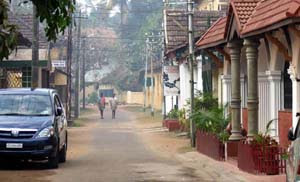







A municipal town from 1866 to 1967, Fort Kochi now is one of the three main urban components that constitute the present day City of Kochi in the Indian State of Kerala, the other two being Mattancherry and Ernakulam> In 1967, these three municipalities, along with a few adjoining areas, were amalgamated to form the new Corporation of Kochi. Fort Cochin in mainly occupied by the Anglo Indians and Dutch settlers left behind by the Europeans visitors to this part, and something to be noted is that still the European culture is being followed by in Fort Cochin. Fort Cochin is the home to some of the oldest European architecture in India and has been a significant settlement ever since Cochin Harbour was discovered. Unlike the bustling Ernakulum, Fort Cochin is sleepy and retains a great deal of colonial charm. A day spent wandering the streets of Fort Cochin will be well spent. Some of the important charming eye catching views in Fort Kochi are the Santa Cruz Basilica,Chinese net, waterfront, Dutch Cemetary, Princess Street, St Francis church, Cochin carnival, Jew street, synagogue, Mattancherry Palace etc.
Santa Cruz Basilica The Portugese built Basilica’s 500th anniversary was very recently. With gracious and admiring interiors, Gothic façade with soaring and dazzling spires the Basilica is a charming prayer home. The Dutch catch of Kochi in 1663 resulted in booming of warehouses in places of worships. The irresistible beauty garnered by stained glass and the imposing Caryatids over the confessional boxes might have persuaded the Dutch to spare it. It is located on Rampart Road. Founded soon after the arrival of the first Portuguese visitors to India Located on Rampart Street. Open: 9-1 and 3-5 with Masses at 7 am and 6 pm. Mass on Saturday at 6pm is in English
Princess Street: Flower-pot laden windowsills, bronze stucco walls and peeling pastel are the peculiarities of colonial style buildings. See them in Princess Street. Princess Street, a segment of Fort Kochi, revels in moody pastimes. In the morning there is a lovely smell of fresh bread and dont forget to load on Loafer Corner where you can see and be seen.
St Francis Church: Built in timber by Portuguese in 1503, it was overlaid with stone masonry later. Vasco da Gama was cremated here in 1524. His remains were later removed to Lisbon. His tomb, however, still exists. The grave stones were tossed into the walls of the church in 1886. The ‘Doop Book’, that is, old baptism and the marriage register, from 1751 to 1804, kept in the vestry, are the delights of history seekers. A photo copy of the Doop Book is kept outside the vestry to enable interested visitors to glance through. Location: Church Road. Open: 6am - 7pm, Mass at 7.15 am
Dutch Cemetary: Old cemetary for the Dutch settlers and colonists from the 17th to 18th century. Interesting and quiet site for exploring the Fort Cochin history. Location: short walk from the lighthouse.
Waterfront: A little walk-away is Vasco da Gama Square, a narrow promenade running along the beach. Huge cantilevered Chinese Fishing Nets, just before the beach are littered in the water as welcome symbols to the visitors. The Chinese Fishing Nets system works in a systemic way. A bamboo and teak (or any hardwood) contraption with net-spread hanging get pulled down to the water and hauled in with the catch. This is done manually. The catching process is usually in the morning and early evening. The Fort Kochi beach is clean and small. At one end there is a pretty Lighthouse. Recline and relax on the white sand when the eyes will sharp on Lakshadweep bound ships. Lakshadweep gets all the consumer and otherwise goods from the mainland Kochi. Ferry to the distanced sporadic Cherai beach. The receptive white sand there is a luring force to recline, sleep, dance or to football. And swim and sniff. If lucky, dolphins can be spotted. Coconut groves and paddy field across the shore add glamour to this beautiful beach.
Kochi Carnival: The last 10 days of December white rules Kochi. All avenues, establishments and houses in Kochi wear white paper buntings. All available space in the streets host impromptu competitions and multi-faceted celebrations. All these are conducted with self-imposed discipline. No trace of unruliness. Kalam Vara (floor drawing), tug-of-war, bicycle races, swimming in sea, beach volleyball are some of the items packed in the competition basket. The festivities and revelries continue till midnight of December 31st. Fireworks mark the finale. All the days of Carnival large number of people gather to enjoy the events.
Jew Street: Once one of the oldest Jewish communities in the world, but now many of the inhabitants have moved to Israel and the once bustling jewish community has now largely shut up shop and the street is quiet. The nearby Market Road still bustles with spice market and tourist curio shops.
Pardesi Synagogue: At one end of Jew Street is Jewish Cemetery Road with its Malayalam and Hebrew tombstones. A short walk brings you to Pardesi Synagogue. Once there were 7 synagogues in Fort Cochin in this street, only Pardesi is still open. The synagogue is 400 years old and its interior holds curved brass columns, an intricately carved teak ark, Belgian crystal chandeliers and Torah crowns of solid gold set with gems. The floor has hand-painted porcelain tiles from Canton, each tile different. The most interesting object are the two copper plates with details of privileges granted to the Jewish community during the reign of Bhaskara Ravi Varman in the 10th century. The 4 dials of the 45 ft clock tower have numerals in Hebrew, Latin, Malayalam and Arabic.Entry Fee: Rs 2 Open: 10-noon, 3-5pm, closed on Fridays, saturdays and Jewish Holidays. (No video cameras)